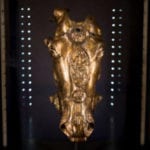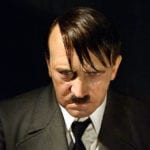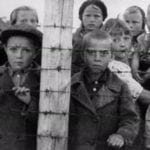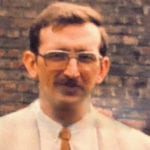 Mysteries
Mysteries  Mysteries
Mysteries  Creepy
Creepy 10 Scary Tales from the Middle Ages That’ll Keep You up at Night
 Humans
Humans 10 One-of-a-kind People the World Said Goodbye to in July 2024
 Movies and TV
Movies and TV 10 Holiday Movies Released at Odd Times of the Year
 Politics
Politics 10 Countries Where Religion and Politics Are Inseparable
 Weird Stuff
Weird Stuff 10 Freaky Times When Famous Body Parts Were Stolen
 Miscellaneous
Miscellaneous 10 Interesting Things Manufacturers Stopped Making and Why
 Gaming
Gaming 10 Funny Tutorials in Games
 History
History 10 Fascinating Little-Known Events in Mexican History
 Facts
Facts 10 Things You May Not Know about the Statue of Liberty
 Mysteries
Mysteries 10 Devastating Missing Child Cases That Remain Unsolved
 Creepy
Creepy 10 Scary Tales from the Middle Ages That’ll Keep You up at Night
 Humans
Humans 10 One-of-a-kind People the World Said Goodbye to in July 2024
Who's Behind Listverse?

Jamie Frater
Head Editor
Jamie founded Listverse due to an insatiable desire to share fascinating, obscure, and bizarre facts. He has been a guest speaker on numerous national radio and television stations and is a five time published author.
More About Us Movies and TV
Movies and TV 10 Holiday Movies Released at Odd Times of the Year
 Politics
Politics 10 Countries Where Religion and Politics Are Inseparable
 Weird Stuff
Weird Stuff 10 Freaky Times When Famous Body Parts Were Stolen
 Miscellaneous
Miscellaneous 10 Interesting Things Manufacturers Stopped Making and Why
 Gaming
Gaming 10 Funny Tutorials in Games
 History
History 10 Fascinating Little-Known Events in Mexican History
 Facts
Facts 10 Things You May Not Know about the Statue of Liberty
10 Horrifying Facts About Chemical Warfare In World War I
It was already a war crime to use chemical weapons when World War I began. Every major country had signed a convention agreeing not to use them. But when the fighting began, the treaties meant nothing.
Chemical warfare was an everyday horror of war. Men huddled in the trenches, watching for the creep of gas clouds or the telling smells that meant a toxic chemical was starting to choke their lungs.
The calls of “Gas! Gas!” that filled the air made World War I unlike any war that had come before it. It was a threat that there was a fate waiting for you that could be worse than death.
10 Germany Opened 6,000 Cylinders Of Chlorine Gas On French Soldiers

The first major gas attack of the war occurred on April 22, 1915, just outside the Belgian town of Ypres. The German army had brought 6,000 cylinders of their newly developed chlorine gas. They waited until the wind was just right and then let it spill out over the French troops.
Technically, the French had started the chemical war. They’d laughed at the first chemical attack back in August 1914 when they’d launched grenades filled with tear gas at the German armies. The grenades had little to no effect on the soldiers, but they started a chemical battle that would get increasingly worse as the war raged on.
When the chlorine gas fell on the soldiers in Ypres, no one was prepared. There had never been a chemical attack like this before, and so not a single soldier had a gas mask ready. Within 10 minutes, thousands had choked to death. The rest were stumbling blindly away, the poison eating at their lungs.
It was “an equivalent death to drowning, only on dry land,” according to one of the men who’d survived it. He felt “a knife edge of pain in the lungs,” he said. “It is a fiendish death to die.”[1]
9 The Wife Of The Inventor Of Chlorine Gas Killed Herself To Get Him To Stop

Among the German soldiers releasing the gas was Fritz Haber, the man who had invented it. He was one of history’s great chemists. After the war, he would even win a Nobel Prize for his agricultural work. But before the war ended, he dedicated himself to finding new and horrible ways to kill the enemies of Germany.
His wife, Clara, a scientific genius in her own right, was appalled by her husband’s work. She called it “a sign of barbarity, corrupting the very discipline which ought to bring new insights into life” and repeatedly begged him to stop.
She was willing to do anything to stop him. When he came back from the front to attend a party in his honor, she stole his pistol, walked into the garden, and shot herself in the heart. She killed herself, all in the hopes that it would get him to stop his massacres.[2]
It didn’t work. At dawn on the very morning after his wife’s dead body was found, Haber went to the Eastern Front to launch another gas attack.
8 Canadian Soldiers Had To Breathe Through Urine-Soaked Rags To Survive
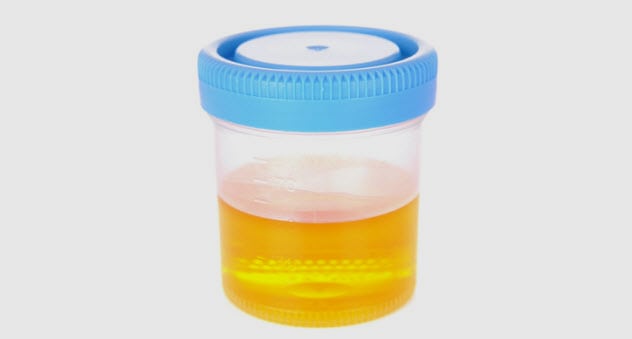
The second batch of chlorine gas was fired at the 1st Canadian Division a mere two days after the first attack.
They hadn’t had much time to learn about the Germans’ new weapons, but they’d picked up a few things. The gas was worse down near the ground and running away only made it choke you more. The best thing to do was to climb up to the top of trenches and hold still, although that made you an easy target.
They still didn’t have gas masks, but the medics had figured out a makeshift solution. They could hold off the effects by covering their mouths with cloths. But it was a lot more effective if they soaked those cloths in urine first.
When the gas came, there was no time to be embarrassed. The Canadians moved up to the tops of the trenches. Those who took their medics’ advice credited it for their lives. “I tied a handkerchief over my nose and mouth,” one survivor recalled. “That saved my life.”
Still, it wasn’t the same as using a gas mask. Approximately 2,000 Canadians died in the battle and left a pile of gas-scarred bodies that would haunt the survivors’ dreams.
One Scottish soldier wrote about it after the war. “When we got to Ypres, we found a lot of Canadians lying there dead from gas the day before,” he said. “Poor devils, and it was quite a horrible sight for us young men.”[3]
7 British Scientists Tested Mustard Gas On Indian Soldiers
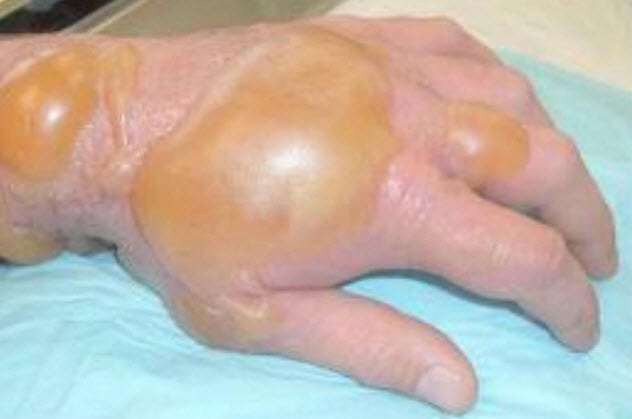
Once the Germans had used chlorine gas, all bets were off. The British ramped up efforts to start using chemicals right along with them. First, though, they needed to test it—and they used their own soldiers to do it.
In 1916, the British army started testing chemical weapons on what would ultimately add up to more than 20,000 British soldiers. Some would later say that they were lied to before doing the experiments and had no idea what was about to happen to them.
Some of the worst experiments happened in Rawalpindi, where British military scientists sent hundreds of Indian soldiers into gas chambers and sprayed them with mustard gas. Their goals were twofold: They wanted to see how much gas it took to create a casualty, and they wanted to see if there were any differences in how it burned Indian skin.
Many of the subjects were unable to walk for weeks after the experiments. They were stuck in hospital beds, agonizing through the pain of having their flesh picked and cleaned.
“Severely burned patients are often very miserable and depressed and in considerable discomfort,” the scientists noted in one of their reports. It was a feeling, they said, which “must be experienced to be properly realized.”[4]
6 Phosgene Gas Attacks Alone Killed Nearly 80,000 People
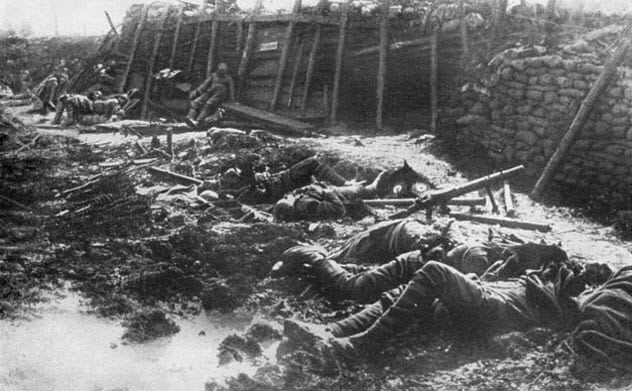
The greatest killer of all the chemical weapons used in the war was phosgene gas. Of the 91,000 soldiers who choked to death from poisonous gases throughout the war, an estimated 85 percent of them died because of phosgene attacks.
It was a slow, secretive killer. It didn’t make its victims choke as much as chlorine gas did, so more of the gas was inhaled into the lungs. It could even be made undetectable. If diluted by just the right amount, it would still be toxic but without the slightest hint of a smell.
Phosgene gas was used for the first time on December 19, 1915, in a city called Wieltje. The Germans released 88 tons of chlorine and phosgene gas together and let it drift into the place where the enemy troops were sleeping.[5]
Few of the men got their gas masks on in time. The gas sneaked in while they were unconscious, seeping into their lungs before they could even understand how bad it truly was.
It was devastating. The attack on Wieltje alone caused 69 deaths and 1,069 casualties. The dead, though, didn’t die quickly. It took 24 hours before the worst symptoms began. Even then, their deaths would drag out for days or weeks.
5 Mustard Gas Put People Through Hell
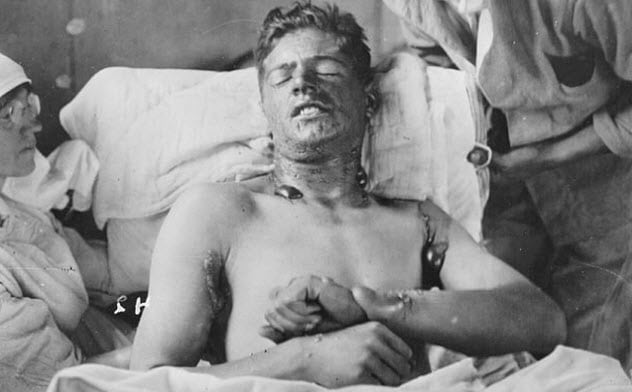
Mustard gas was the most feared chemical weapon in World War I, but that wasn’t because it was so lethal. Mustard gas only killed 2–3 percent of the people who breathed it in, but it left those who survived in unimaginable agony.
When a soldier breathed in mustard gas, his skin would start to blister, his eyes would start to puff up, and his vision would fail. He’d start bleeding both inside his body and on the outside, where the gas was peeling his flesh away. Most would end up vomiting, and if the gas did kill them, it would take weeks before they died.
“I wish those people who talk about going on with this war whatever it costs could see the soldiers suffering from mustard gas poisoning,” one British nurse said. “Great mustard-colored blisters, blind eyes, all sticky and stuck together, always fighting for breath, with voices a mere whisper, saying that their throats are closing and they know they will choke.”[6]
4 Up To 260,000 Civilians Were Gassed During The War
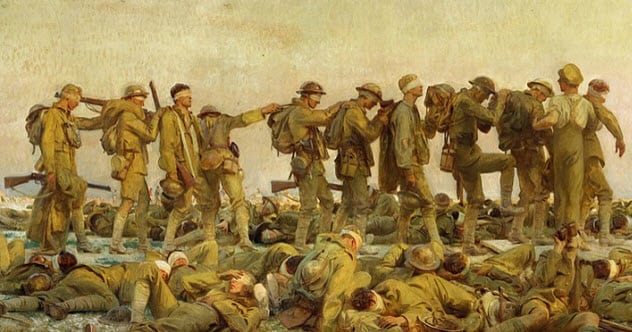
It wasn’t just the soldiers who were caught in the middle of the chemical warfare. Those gases crept past the battlefields and into towns and cities where civilians—including children—were sleeping.
There were between 100,000 and 260,000 civilian casualties caused by chemicals during the war. Some weren’t lucky enough for such a quick death. It’s believed that tens of thousands more died of their symptoms after the war ended. In the meantime, they lingered on for years with scarred lungs, burned skin, and serious brain damage from the gases.
The armies knew that their chemical weapons were killing civilians. British Field Marshal Douglas Haig wrote openly about it in his diary:
My officers and I were aware that such weapon would cause harm to women and children living in nearby towns, as strong winds were common in the battlefront. However, because the weapon was to be directed against the enemy, none of us were overly concerned at all.[7]
3 America Was Building A Super Chemical Weapon
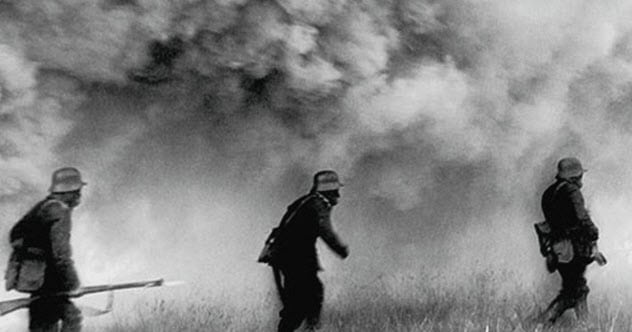
In the final years of the war, the US army was developing a secret chemical weapon called lewisite. It was a horrific weapon: A single drop would make a person break out with large, pus-filled blisters, while a bigger dose would tear up their insides until they choked on the shredded linings of their own airways.
By 1918, more than 10 percent of the chemists in the US had been conscripted to work on the government’s secret chemical weapon project. Some were even pushed to test it on their own bodies. They would pour the chemical on their own flesh to see its effects.
In August 1918, the people of Washington, DC, became accidental test subjects when an explosion in the lab sent lewisite spilling out into the city. It gassed the people who lived near the secret factory—choking them and leaving them with severe burns and outright killing some of the animals.
It could have been worse. Only 3.6 kilograms (8 lb) of lewisite got out during that accident. By the end of the war, America was producing 10 tons of lewisite each day.[8]
2 The US Army Secretly Dumped A Huge Amount Of Gas Into The Ocean

After the war was over, the US Army decided to get rid of most of the chemical weapons they’d created—by dumping them into the ocean.
In total, they dumped 29 million kilograms (64 million lb) of chemical weaponry into the sea before they finally started looking for better ways to do it. They didn’t change their approach until the 1970s. In the meantime, they dumped bombs, rockets, and more than 500 tons of radioactive waste into the ocean with those chemical weapons.
They were found out when a clam-dredging team picked up an artillery shell full of mustard gas and, not knowing what it was, cracked it open. Even after decades underwater, the gas was still potent enough to hospitalize the people there.
The waste was dumped on every corner of the country. There were dump sites in both oceans and even around Hawaii and Alaska—and they didn’t even bother keeping track of where it all was, especially the weapons dumped during World War I. The US Army Chemical Materials Agency was forced to admit: “We do not claim to know where they all are.”[9]
America wasn’t the only country to do it, though. The British and the Russians dumped chemical weapons in the ocean, too. In the Baltic Sea, it’s said that the fish have started to mutate from the effects of the mustard gas.
1 The US Government Tested Chemical Weapons On 60,000 Of Their Own Soldiers
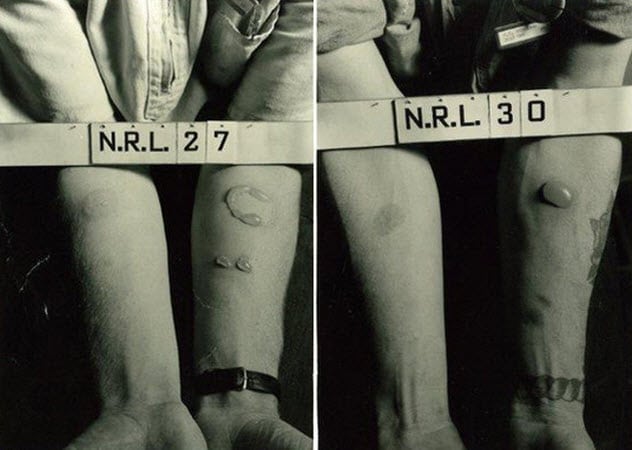
The war ended before the Americans could put lewisite to use. But they kept testing it, even after the war was over. During the next few years, the American government tested chemical weapons on 60,000 of its own soldiers.
Black, Puerto Rican, and Japanese soldiers were the main targets for their tests. The government wanted to find out if there was a race of people who were super-resistant to chemicals. So they sent nearly every soldier with a foreign nationality into the gas chambers to see how they’d stand up to lewisite and mustard gas.
“It felt like you were on fire,” one of the men who was subjected to the tests later said. “Guys started screaming and hollering and trying to break out. And then some of the guys fainted. And finally, they opened the door and let us out, and the guys were just, they were in bad shape.”[10]
The soldiers were threatened into silence. If they told a soul what had happened, they would be dishonorably discharged and thrown into prison. That was a major problem. The effects lingered for the rest of their lives, and the men were unable to tell their doctors what had gone wrong.
When the truth finally came out, most of the subjects were in their nineties. One man, who was 93 years old, showed a reporter how dead skin still fell off his body in flakes more than 70 years after his government had doused him in toxic chemicals.
Read more horrifying facts and some misconceptions about World War I on Top 10 Facts You Didn’t Know About World War I and 10 Myths And Misconceptions About World War I.
